剑桥标准英语教程-教案
剑桥规范标准英语教育教案课程教案
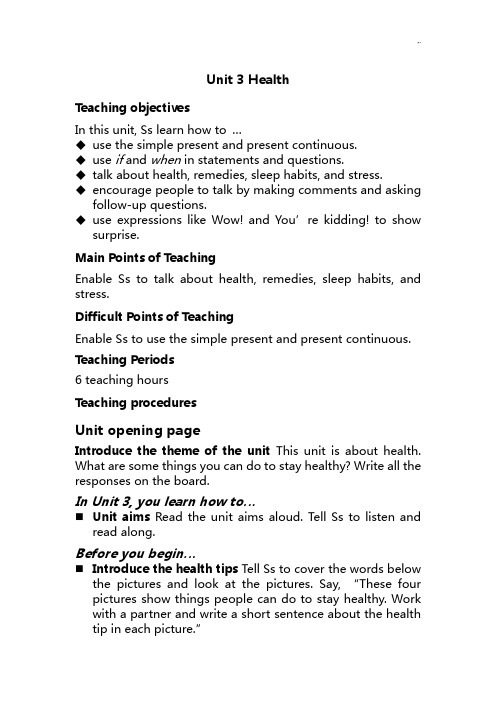
Unit 3 HealthTeaching objectivesIn this unit, Ss learn how to …◆use the simple present and present continuous.◆use if and when in statements and questions.◆talk about health, remedies, sleep habits, and stress.◆encourage people to talk by making comments and askingfollow-up questions.◆use expressions like Wow! and You’re kidding! to showsurprise.Main Points of TeachingEnable Ss to talk about health, remedies, sleep habits, and stress.Difficult Points of TeachingEnable Ss to use the simple present and present continuous. Teaching Periods6 teaching hoursTeaching proceduresUnit opening pageIntroduce the theme of the unit This unit is about health. What are some things you can do to stay healthy? Write all the responses on the board.In Unit 3, you learn how to…⏹Unit aims Read the unit aims aloud. Tell Ss to listen andread along.Before you begin…⏹Introduce the health tips Tell Ss to cover the words belowthe pictures and look at the pictures. Say, “These four pictures show things people can do to stay healthy. Work with a partner and write a short sentence about the health tip in each picture.”⏹Ask several pairs to share their tips with the class. Writetheir sentences on the board.⏹Read the sentences below the pictures aloud. Ss listen andrepeat. Help with new vocabulary as needed. Ss practice reading the sentences.⏹Ask the class, “Which of the things in the pictures do u doto stay healthy?”Have several Ss answer. Ask, “What else can u do? Use ideas from the board, or think of more things to do.”⏹Ss ask and answer in pairs. Then ask several Ss to reporttheir answers to the class.Lesson A Healthy living1 Getting started⏹Ste the scene Read the lesson title aloud. Ask, “What aresome things u do to stay healthy?”Ask a few Ss to answer.Ask, “Who is doing sth special, or different, to stay or get healthy right now?”Ask a few Ss to answer.A⏹Preview the task Read the instructions aloud.⏹Play the recording First, Ss read along. Then Ss listenwithout looking at books and write their answers.⏹Have Ss compare their answers in pairs. Check answers withthe class.B⏹Preview the task Say, “Read the interviews again. Look fortime words and expressions. Write these column headings on the board: Routines (All the time) and Temporary Events (Now). Ask a few Ss to call out the time expressions for the first headings, and write them on the board. Ask, “What verb tense do u see in the sentences with these time expressions?”⏹Ask a few Ss to call out the time expressions for the secondheading, and write them on the board. Ask, “What verb tense do u see in the sentences with these time expressions?”⏹Read the instructions aloud.⏹Do the task.⏹Have Ss compare their answers in pairs. Check answers withclass.2 Grammar⏹Present the grammar chart⏹Understand the grammar Say, “The grammar chartcompares the simple the simple present and the present continuous.”Explain that the simple present is used to talk about regular or repeated events or routines and situations are true all the time. And the present continuous is used for activities and events that are temporary, or going on around now. It is also used for activities that are going on at the time of speaking.⏹Present In Conversation Read the information aloud. HaveSs make a sentence in the simple present for each of the verbs presented.A⏹Preview the task Have Ss look at the picture. Ask, “What isshe doing?”Ask, “What is on the table?”(an aromatherapy burner) Read the instructions and the example aloud. Ask, “Why is the simple present the correct tense?”(It’s asking how u cope with stress in general or all the time.)⏹Do the task2 Listening and speakingA⏹Preview the task Say, “You will hear four people talkingabout their unhealthy habits. Read the incomplete statements and guess what each person says. Write your guesses.”⏹When Ss finish, ask a few Ss to call out their guesses foreach statement. Say, “Now listen and write what they actually say.”⏹Play the recording Ss listen and write the missing words.Check answers with the class.Lesson B Aches and pains1 Building vocabulary⏹Ste the scene Hold your head as if it hurts. Say, “I have aheadache.”Write a headache on the board. Hold your stomach as if it hurts. Say, “I have a stomachache.”Write it on the board. Ask, “What other health problems do u know the words for in English?”Write Ss’responses on the board.A⏹Preview the task Read the instructions aloud. Have SS lookat the pictures.⏹Play the recording Ss listen and repeat.⏹Ask, “Do u have any of these problems right now? If yes,raise your hand.”Ask any Ss who raise their hands, “Which problem do u have?”B⏹Preview the task Ask Ss to look at the chart. Read theinstructions aloud. Tell Ss to use ideas from the lists on the board or their own ideas.⏹Do the task2 Speaking naturallyA⏹Preview the task Have Ss look at the conversation. Say,“When people are speaking, they put stress on the words that are important in the sentence. An important word can be, for example, the answer to a question.”Say, “Stress is also used to contrast, or correct, information. For example, imagine I call u by the wrong name. When u correct me, u say your name clearly and a little more loudly.”⏹Read the instructions aloud.⏹Play the recording Ss listen and repeat.B⏹Preview the task Tell pairs to practice the conversation inPart A, taking turns playing each role. Read the instructions aloud.⏹Do the task3 Building language⏹Set the scene Write on the board: remedy. Explain, “Aremedy is used to fix a problem. For example, one remedyfor a headache is to take an aspirin. Imagine you have a cold. What remedy do u use?”Write Ss’responses on the board.A⏹Preview the task Look at the picture. Say, “Sonia and Markare talking on the phone. Where’s Mark?”(at home) “What’s wrong with her?”(He’s sick.) “What do u think Sonia and Mark are talking about?”(a remedy)⏹Books closed. Say, “What does Sonia want to make forMark? Listen and write the answer.”⏹Play the recording For the first time, Ss listen and write theanswer without looking at books; for the second time, Ss listen, read along, and review their answer. Then check the answer with the class⏹Practice the conversation in pairs.B⏹Preview the task Tell Ss to find if and when in theconversation and circle them. Ask, “What tense are the two verbs in each sentence?”⏹Do the task4 Grammar⏹Present the grammar chart⏹Understand the grammar Say, “When and if have verysimilar meanings. You can use when to talk about a situation that is usual for u, and u can use if to talk about a situation that is not so usual. But both are possible in the sentences in the chart.”A⏹Preview the task Read the instructions and the phrasesfrom No. 1 aloud. Read the example conversation. Remind Ss that they can put the part with when at the start of the sentence or after the other part. Have Ss complete the task.⏹Have Ss check answers in pairs. Then check answers withthe class.B⏹Preview and do the task.Lesson C How come you’re tired?1 Conversation strategy⏹Set the scene Read the title of the lesson aloud. Ask,“What does how come mean?”(why) Say, “Think about the title. Try to guess some of the words that are in the conversation in this lesson.”As Ss call out their guesses, write them on the board.A⏹Preview the task Tell Ss to look at A’s statement. Read italoud. Say, “Read B’s responses. Which are the best to keep the conversation going? Check the boxes.”Have Ss compare their answers in pairs. Check answers with the class.⏹Books closed. Read the instructions aloud.⏹Play the recording Books open. Ss listen and read along.⏹Play the recording again Ask, “Why is Adam tired?”Sslisten and write the answer.⏹Play the recording again Ss listen, read along, and reviewtheir answers. Check answers with the class.⏹Ask Ss to read the conversation again and circle any wordsthat they guessed would be in the conversation. As Ss call them out, circle them on the board.⏹Practice Have Ss practice the conversation in pairs.B⏹Preview the task Have Ss read the sentences and replies.⏹Do the taskC⏹Preview and do the task Read the instructions aloud. Tomodel the task, have two Ss read the example conversation.Have pairs use the sentences in Part B for ideas and give their own answers. Remind Ss to say more than just yes or no.2 Strategy plus⏹Find examples Say, “Look at the conversation on p.26again. Find the expressions that Yuki uses to show surprise.⏹Present Strategy plus Read the information and theexamples aloud. Ask, “Why does Yuki say ‘You’re kidding!’”⏹Present In Conversation Books closed. Write on the board:Oh, Wow, Really, and Gosh. Say, “Two of these are in the top 50 words, and two are in the top 500 words. Which two are in the top 50? Which two are in the top 500? Write your guesses.”Books open. Ask a S to read the information.Have Ss raise their hands if they guessed correctly.A⏹Preview the task Have Ss read the conversations. Say,“Now listen and write the expressions you hear.”⏹Play the recording Ss listen and read along. Listen againand write the expressions.⏹Check answers with the class.⏹Have Ss practice the conversation in pairs.B⏹Preview the task.⏹Play the recording Ss listen, then write the expression. Sslisten again. Then check answers with the class.3 Talk about it⏹Preview the task Read the instructions aloud. Ask Ss toread the discussion questions. Make sure that Ss understand the meaning of each question.⏹Do the task Have Ss discuss the questions in groups. Say,“When u find sth u have in common, make notes.”Lesson D Ways to relax1 Reading⏹Set the scene Read the title of the lesson aloud. Ask, “Howdo u relax? What do u do?”Get ideas from Ss.APrereading⏹Preview the task Write the word stressed on the board.Ask, “What does stressed mean?”Get ideas from Ss.⏹Do the taskBDuring reading⏹Preview the reading Have Ss look at the reading. Say,“This is a leaflet. A leaflet is usually one piece of paper with helpful information.”⏹Read the instructions aloud. Tell Ss to circle two new orinteresting things they learn as they read.⏹Do the reading Have Ss rend the leaflet and circle theinformation.⏹When Ss finish, call on a few Ss to tell the class theinformation they circled.⏹Do the reading again Have Ss read the leaflet again andunderline any new vocabulary. Help with new vocabulary as needed.CPostreading⏹Preview the task⏹Do the task Have Ss answer the questions and thencompare their answers pairs. Check answers with the class.2 Listening⏹Set the scene Tell Ss to look at the pictures. Ask, “Whereare the people? What are they doing?”Get ideas from Ss. A⏹Preview and do the task Read the instructions aloud. HaveSs work in pairs and discuss the questions⏹Call on several Ss to tell the class what they do to relax.B⏹Preview the task Read the instructions aloud.⏹Play the recording Play the first conversation. Ask, “Whichpicture does this conversation go with?”Then ask, “What words in the conversation help u choose this picture?”⏹Play the remaining conversations, and have Ss write theiranswers. Check answers with the class.C⏹Preview the task Read the instructions aloud.⏹Play the recording Play the first conversation, and thenpause the recording. Ask, “What else does she do to relax?”Ss write the answer under the picture they labeled1.⏹Play the remaining conversations. Ss listen and write theactivities.⏹Play the recording again Ss listen and review their answers.Check answers with the class.3 WritingA⏹Preview the task Ask some general questions aboutcommon health problems.⏹Read the instructions aloud. Call on four Ss to each read anexample.⏹Do the task Have Ss write a common health problem on apiece of paper.B⏹Preview the task Read the instructions aloud. Call ondifferent Ss to each read the example problem and the replies.⏹Present the Help note⏹Ask Ss to read some of the problems they wrote in Part A.Give suggestions using sentences with if when clauses.⏹Do the task Have Ss pass their papers around their group,and write a reply to each person.。
小学剑桥英语备课教案模板
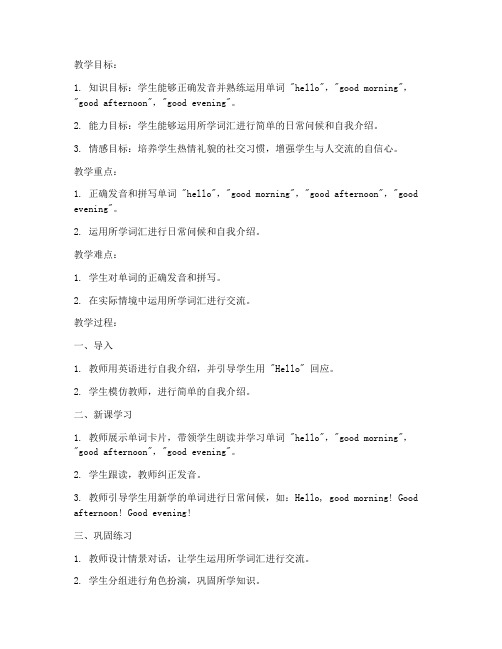
教学目标:1. 知识目标:学生能够正确发音并熟练运用单词 "hello","good morning","good afternoon","good evening"。
2. 能力目标:学生能够运用所学词汇进行简单的日常问候和自我介绍。
3. 情感目标:培养学生热情礼貌的社交习惯,增强学生与人交流的自信心。
教学重点:1. 正确发音和拼写单词 "hello","good morning","good afternoon","good evening"。
2. 运用所学词汇进行日常问候和自我介绍。
教学难点:1. 学生对单词的正确发音和拼写。
2. 在实际情境中运用所学词汇进行交流。
教学过程:一、导入1. 教师用英语进行自我介绍,并引导学生用 "Hello" 回应。
2. 学生模仿教师,进行简单的自我介绍。
二、新课学习1. 教师展示单词卡片,带领学生朗读并学习单词 "hello","good morning","good afternoon","good evening"。
2. 学生跟读,教师纠正发音。
3. 教师引导学生用新学的单词进行日常问候,如:Hello, good morning! Good afternoon! Good evening!三、巩固练习1. 教师设计情景对话,让学生运用所学词汇进行交流。
2. 学生分组进行角色扮演,巩固所学知识。
四、课堂小结1. 教师带领学生回顾本节课所学内容。
2. 学生用所学词汇进行自我介绍。
五、作业布置1. 学生回家后,用所学词汇进行家庭英语角活动,与家长进行简单交流。
2. 学生预习下一节课内容。
教学资源:1. 单词卡片2. 多媒体课件3. 情景图片教学反思:本节课通过多种教学方式,如教师示范、学生跟读、情景对话、角色扮演等,让学生在轻松愉快的氛围中学习新知识。
剑桥标准英语教程 教师用书
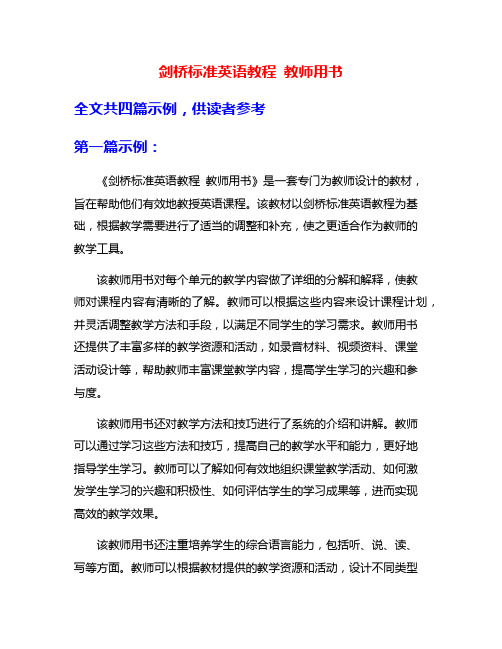
剑桥标准英语教程教师用书全文共四篇示例,供读者参考第一篇示例:《剑桥标准英语教程教师用书》是一套专门为教师设计的教材,旨在帮助他们有效地教授英语课程。
该教材以剑桥标准英语教程为基础,根据教学需要进行了适当的调整和补充,使之更适合作为教师的教学工具。
该教师用书对每个单元的教学内容做了详细的分解和解释,使教师对课程内容有清晰的了解。
教师可以根据这些内容来设计课程计划,并灵活调整教学方法和手段,以满足不同学生的学习需求。
教师用书还提供了丰富多样的教学资源和活动,如录音材料、视频资料、课堂活动设计等,帮助教师丰富课堂教学内容,提高学生学习的兴趣和参与度。
该教师用书还对教学方法和技巧进行了系统的介绍和讲解。
教师可以通过学习这些方法和技巧,提高自己的教学水平和能力,更好地指导学生学习。
教师可以了解如何有效地组织课堂教学活动、如何激发学生学习的兴趣和积极性、如何评估学生的学习成果等,进而实现高效的教学效果。
该教师用书还注重培养学生的综合语言能力,包括听、说、读、写等方面。
教师可以根据教材提供的教学资源和活动,设计不同类型的教学内容,帮助学生全面提高语言能力。
通过多样化的课堂活动和练习,学生可以更全面、更系统地掌握语言知识和运用能力,从而更好地应对日常生活和学习需求。
在教学实践中,教师用书还注重培养学生的学习策略和自主学习能力。
教师可以通过设计启发性的教学活动,引导学生主动思考、自主学习,从而培养他们的学习兴趣和自主学习能力。
教师还可以根据学生的学习情况和需要,调整和改进自己的教学方法和手段,以更好地满足学生的学习需求。
《剑桥标准英语教程教师用书》是一本优秀的教学工具,可以帮助教师更好地组织和指导英语课程,提高学生的语言能力和综合素质。
教师可以通过学习和应用该教师用书,不断提升自己的教学水平和能力,为学生的学习和成长做出更大的贡献。
希望更多的教师能够利用这本教师用书,开展更富有成效的英语教学工作。
第二篇示例:剑桥标准英语教程(Cambridge English: Standard Course Teacher's Book)是一本针对中级水平学生设计的全面英语教材。
剑桥版英语教案设计模板

一、教学目标1. 知识目标:- 学生能够掌握本节课的词汇和句型。
- 学生能够理解并运用所学知识进行简单的交流。
2. 能力目标:- 提高学生的听说能力。
- 培养学生的英语思维习惯。
3. 情感目标:- 激发学生学习英语的兴趣。
- 增强学生的自信心和合作意识。
二、教学内容根据教材内容和教学目标,选择合适的教学内容。
以下为示例:- 单元主题:家庭- 主要词汇:father, mother, brother, sister, home, room, kitchen, bedroom- 主要句型:This is my family. I have a... He/She is...三、教学重点与难点1. 教学重点:- 词汇:father, mother, brother, sister, home, room, kitchen, bedroom- 句型:This is my family. I have a...2. 教学难点:- 词汇的正确发音和拼写。
- 句型的灵活运用。
四、教学过程1. 导入(5分钟)- 利用图片、视频或实物展示家庭场景,激发学生的学习兴趣。
- 提问:What is this? Who are they? 引导学生复习相关词汇。
2. 新授(15分钟)- 教师展示家庭成员的图片,引导学生说出对应的词汇。
- 教师示范句型,学生跟读并模仿。
- 学生分组练习,互相介绍自己的家庭。
3. 练习(15分钟)- 进行词汇卡片游戏,巩固所学词汇。
- 学生分组进行对话练习,运用所学句型介绍自己的家庭。
4. 拓展(10分钟)- 教师出示图片,学生根据图片内容进行问答。
- 学生发挥想象力,描述自己的理想家庭。
5. 小结(5分钟)- 教师总结本节课所学内容,强调重点词汇和句型。
- 学生回顾所学知识,分享自己的学习心得。
五、教学评价1. 课堂表现:- 学生参与课堂活动的积极性。
- 学生对词汇和句型的掌握程度。
2. 课后作业:- 完成课后练习题,巩固所学知识。
小学剑桥英语教案

一、教案名称:小学剑桥英语一级教案二、教学目标:1. 学生能够掌握基本的英语字母、单词和简单的句子结构。
2. 学生能够进行简单的自我介绍和日常交流。
3. 学生能够听懂并模仿简单的英语语音和语调。
三、教学内容:1. 字母表:A-Z2. 基本单词:hello, good morning, good afternoon, good evening, how are you, my name is, nice to meet you, e e等。
3. 简单句子结构:主语+谓语+宾语四、教学方法:1. 直观教学法:通过图片、实物、动作等直观手段,帮助学生理解和记忆单词和句子。
2. 情景教学法:创设真实的交流情景,让学生在实际语境中练习英语。
3. 模仿教学法:让学生多听、多模仿,提高英语听说能力。
五、教学步骤:1. 热身活动:教师与学生用中文进行简单的自我介绍,引导学生用英语进行自我介绍。
2. 字母学习:教师出示字母表,引导学生跟读并记忆字母。
3. 单词学习:教师展示单词卡片,引导学生跟读并记忆单词。
4. 句子练习:教师创设情境,引导学生用所学单词和句子进行交流。
5. 总结与作业:教师对本节课所学内容进行总结,布置作业,要求学生复习字母和单词。
六、教案名称:小学剑桥英语二级教案七、教学目标:1. 学生能够扩展词汇量,掌握更多的日常用语。
2. 学生能够进行简单的阅读和写作,理解简单的故事情节。
3. 学生能够运用所学的英语知识进行日常交流。
八、教学内容:1. 扩展字母表:A-Z2. 日常用语:ask for help, give thanks, express feelings等。
3. 简单句子结构:主语+谓语+宾语,主语+谓语+状语九、教学方法:1. 情境教学法:通过设置情境,让学生在实际语境中练习英语。
2. 任务型教学法:通过完成任务,提高学生的综合语言运用能力。
3. 互动式教学法:引导学生积极参与课堂互动,提高英语听说能力。
剑桥少儿英语教案模板

一、课程信息1. 课程名称:剑桥少儿英语2. 课程级别:预备级3. 课程单元:Unit 1 Greetings4. 课时:2课时5. 教学目标:- 学生能够使用简单的英语问候他人。
- 学生能够说出基本的问候语,如“Good morning/afternoon/evening”。
- 学生能够理解并回应简单的问候。
二、教学准备1. 教学图片:包括人物、动物、日常用品等。
2. 教学卡片:包含问候语单词和图片。
3. 录音设备:播放问候语的标准发音。
4. 白板或黑板:用于书写和展示教学内容。
三、教学步骤第一课时1. 导入新课(5分钟)- 教师用简单的英语问候学生,如“Good morning, everyone!”- 学生回应教师的问候,并互相问候。
2. 新课学习(20分钟)- 教师展示教学图片,如人物、动物等,引导学生说出相应的物品名称。
- 教师引入问候语,如“Good morning”等,并示范发音。
- 学生跟读并模仿教师的发音。
3. 互动练习(10分钟)- 教师组织学生进行小组活动,让学生互相问候,并用英语说出自己的名字。
- 学生轮流展示,其他学生猜测他们的名字。
4. 总结回顾(5分钟)- 教师带领学生回顾本节课所学内容,强调问候语的正确使用。
第二课时1. 复习导入(5分钟)- 教师询问学生上一节课学到了什么,检查学生的掌握情况。
2. 新课学习(20分钟)- 教师展示更多教学图片,如不同的时间(morning, afternoon, evening)。
- 教师引入不同的问候语,如“Good morning, Good afternoon, Good evening”。
- 学生跟读并模仿教师的发音。
3. 互动练习(10分钟)- 教师组织学生进行角色扮演,模拟不同的场景,如上学、购物等,使用问候语进行交流。
- 学生分组练习,教师巡回指导。
4. 总结回顾(5分钟)- 教师带领学生回顾本节课所学内容,强调不同时间使用不同的问候语。
剑桥英语教案初中
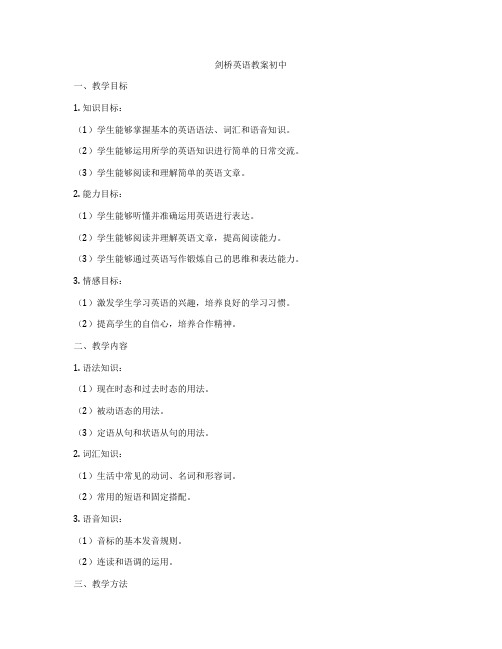
剑桥英语教案初中一、教学目标1. 知识目标:(1)学生能够掌握基本的英语语法、词汇和语音知识。
(2)学生能够运用所学的英语知识进行简单的日常交流。
(3)学生能够阅读和理解简单的英语文章。
2. 能力目标:(1)学生能够听懂并准确运用英语进行表达。
(2)学生能够阅读并理解英语文章,提高阅读能力。
(3)学生能够通过英语写作锻炼自己的思维和表达能力。
3. 情感目标:(1)激发学生学习英语的兴趣,培养良好的学习习惯。
(2)提高学生的自信心,培养合作精神。
二、教学内容1. 语法知识:(1)现在时态和过去时态的用法。
(2)被动语态的用法。
(3)定语从句和状语从句的用法。
2. 词汇知识:(1)生活中常见的动词、名词和形容词。
(2)常用的短语和固定搭配。
3. 语音知识:(1)音标的基本发音规则。
(2)连读和语调的运用。
三、教学方法1. 任务型教学法:通过完成各种真实的任务,激发学生的学习兴趣,培养学生的实践能力。
2. 情境教学法:创设各种真实的语言环境,让学生在实践中学习英语。
3. 交际教学法:注重学生之间的互动,提高学生的交际能力。
4. 游戏教学法:通过趣味性的游戏,让学生在轻松愉快的氛围中学习英语。
四、教学步骤1. 热身活动(5分钟):引导学生进行简单的英语对话,复习已学的知识。
2. 新课导入(15分钟):(1)讲解新的语法知识,通过例句和练习让学生理解和掌握。
(2)教授新的词汇,结合图片和实物进行讲解,让学生直观地理解。
(3)介绍新的语音知识,进行发音练习。
3. 课堂活动(20分钟):(1)分组进行角色扮演,让学生运用所学的语法和词汇进行交流。
(2)进行听力练习,提高学生的听力能力。
(3)进行写作练习,锻炼学生的写作能力。
4. 巩固练习(10分钟):布置一些相关的练习题,让学生巩固所学知识。
5. 总结与作业布置(5分钟):对本节课所学内容进行总结,布置作业,要求学生复习和巩固所学知识。
五、教学评价1. 课堂表现:观察学生在课堂上的参与程度、表现力和合作精神。
剑桥英语教案高中模板
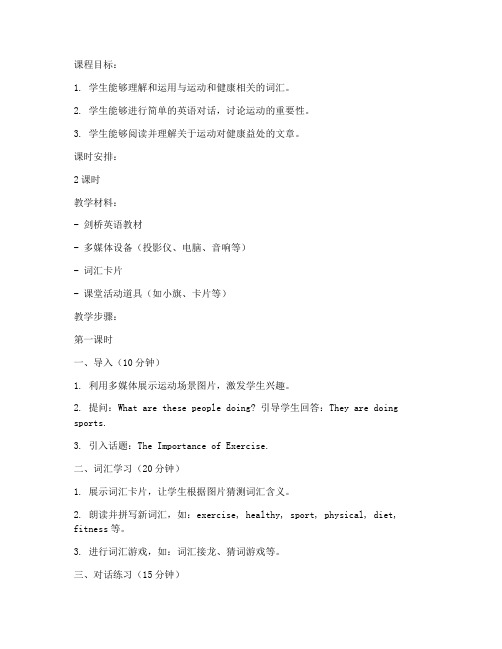
课程目标:1. 学生能够理解和运用与运动和健康相关的词汇。
2. 学生能够进行简单的英语对话,讨论运动的重要性。
3. 学生能够阅读并理解关于运动对健康益处的文章。
课时安排:2课时教学材料:- 剑桥英语教材- 多媒体设备(投影仪、电脑、音响等)- 词汇卡片- 课堂活动道具(如小旗、卡片等)教学步骤:第一课时一、导入(10分钟)1. 利用多媒体展示运动场景图片,激发学生兴趣。
2. 提问:What are these people doing? 引导学生回答:They are doing sports.3. 引入话题:The Importance of Exercise.二、词汇学习(20分钟)1. 展示词汇卡片,让学生根据图片猜测词汇含义。
2. 朗读并拼写新词汇,如:exercise, healthy, sport, physical, diet, fitness等。
3. 进行词汇游戏,如:词汇接龙、猜词游戏等。
三、对话练习(15分钟)1. 分组进行角色扮演,模拟日常对话场景,如:询问对方是否喜欢运动、讨论运动的好处等。
2. 教师巡回指导,纠正发音和语法错误。
四、课堂小结(5分钟)1. 总结本节课所学新词汇和对话内容。
2. 布置课后作业。
第二课时一、复习导入(10分钟)1. 回顾上节课所学内容,检查学生掌握情况。
2. 展示运动场景图片,让学生用英语描述。
二、阅读理解(20分钟)1. 分发课文,让学生阅读并回答问题。
2. 讨论课文内容,如:运动对健康的益处、如何保持健康等。
3. 教师总结课文重点,并解释生词和短语。
三、课堂活动(15分钟)1. 进行小组讨论,让学生分享自己最喜欢的运动。
2. 每组选派代表进行展示,其他组进行评价。
四、课堂小结(5分钟)1. 总结本节课所学内容,强调运动对健康的重要性。
2. 布置课后作业。
教学评价:1. 观察学生在课堂上的参与度和表现,如:回答问题、参与活动等。
2. 检查学生的作业完成情况,如:词汇卡片、课文阅读理解等。
剑桥英语教案
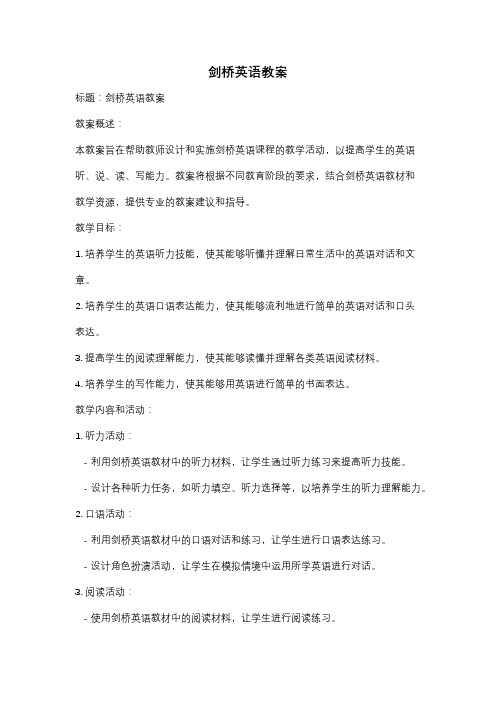
剑桥英语教案标题:剑桥英语教案教案概述:本教案旨在帮助教师设计和实施剑桥英语课程的教学活动,以提高学生的英语听、说、读、写能力。
教案将根据不同教育阶段的要求,结合剑桥英语教材和教学资源,提供专业的教案建议和指导。
教学目标:1. 培养学生的英语听力技能,使其能够听懂并理解日常生活中的英语对话和文章。
2. 培养学生的英语口语表达能力,使其能够流利地进行简单的英语对话和口头表达。
3. 提高学生的阅读理解能力,使其能够读懂并理解各类英语阅读材料。
4. 培养学生的写作能力,使其能够用英语进行简单的书面表达。
教学内容和活动:1. 听力活动:- 利用剑桥英语教材中的听力材料,让学生通过听力练习来提高听力技能。
- 设计各种听力任务,如听力填空、听力选择等,以培养学生的听力理解能力。
2. 口语活动:- 利用剑桥英语教材中的口语对话和练习,让学生进行口语表达练习。
- 设计角色扮演活动,让学生在模拟情境中运用所学英语进行对话。
3. 阅读活动:- 使用剑桥英语教材中的阅读材料,让学生进行阅读练习。
- 设计阅读理解题目,帮助学生提高阅读理解能力。
4. 写作活动:- 引导学生根据所学内容,进行简单的书面表达练习,如写日记、写信等。
- 提供写作模板和指导,帮助学生提高写作水平。
教学评估:1. 利用剑桥英语教材中的评估材料,进行听力、口语、阅读和写作的评估。
2. 设计各类测试题目,如听力理解题、口语对话题、阅读理解题和写作题,以检测学生的英语能力。
教学资源:1. 剑桥英语教材和教学辅助资料。
2. 多媒体设备,如投影仪、音频设备等,用于播放听力材料和展示教学内容。
3. 课堂练习题和评估材料。
教学时长:根据具体教学计划和学校要求,确定每节课的教学时长。
教学反思:根据学生的学习情况和教学效果,及时进行教学反思和调整,以提高教学质量和学生的学习成效。
剑桥少儿英语教案(全)
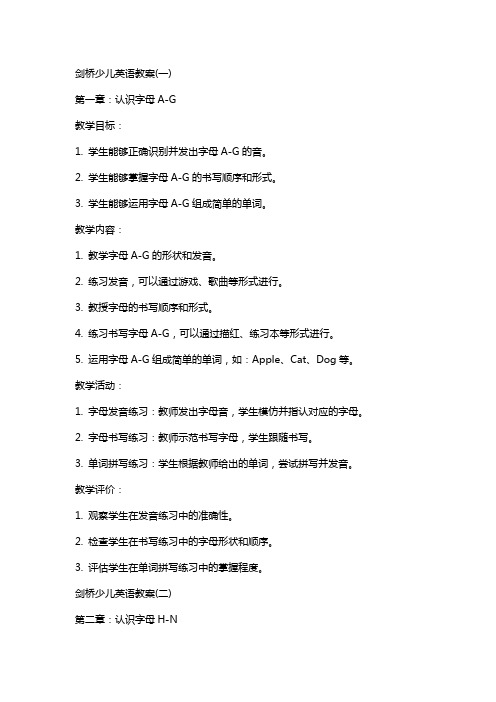
剑桥少儿英语教案(一)第一章:认识字母A-G教学目标:1. 学生能够正确识别并发出字母A-G的音。
2. 学生能够掌握字母A-G的书写顺序和形式。
3. 学生能够运用字母A-G组成简单的单词。
教学内容:1. 教学字母A-G的形状和发音。
2. 练习发音,可以通过游戏、歌曲等形式进行。
3. 教授字母的书写顺序和形式。
4. 练习书写字母A-G,可以通过描红、练习本等形式进行。
5. 运用字母A-G组成简单的单词,如:Apple、Cat、Dog等。
教学活动:1. 字母发音练习:教师发出字母音,学生模仿并指认对应的字母。
2. 字母书写练习:教师示范书写字母,学生跟随书写。
3. 单词拼写练习:学生根据教师给出的单词,尝试拼写并发音。
教学评价:1. 观察学生在发音练习中的准确性。
2. 检查学生在书写练习中的字母形状和顺序。
3. 评估学生在单词拼写练习中的掌握程度。
剑桥少儿英语教案(二)第二章:认识字母H-N教学目标:1. 学生能够正确识别并发出字母H-N的音。
2. 学生能够掌握字母H-N的书写顺序和形式。
3. 学生能够运用字母H-N组成简单的单词。
教学内容:1. 教学字母H-N的形状和发音。
2. 练习发音,可以通过游戏、歌曲等形式进行。
3. 教授字母的书写顺序和形式。
4. 练习书写字母H-N,可以通过描红、练习本等形式进行。
5. 运用字母H-N组成简单的单词,如:House、Insect、Monkey等。
教学活动:1. 字母发音练习:教师发出字母音,学生模仿并指认对应的字母。
2. 字母书写练习:教师示范书写字母,学生跟随书写。
3. 单词拼写练习:学生根据教师给出的单词,尝试拼写并发音。
教学评价:1. 观察学生在发音练习中的准确性。
2. 检查学生在书写练习中的字母形状和顺序。
3. 评估学生在单词拼写练习中的掌握程度。
剑桥少儿英语教案(三)第三章:认识字母O-U教学目标:1. 学生能够正确识别并发出字母O-U的音。
2. 学生能够掌握字母O-U的书写顺序和形式。
剑桥英语示范教案(5篇)
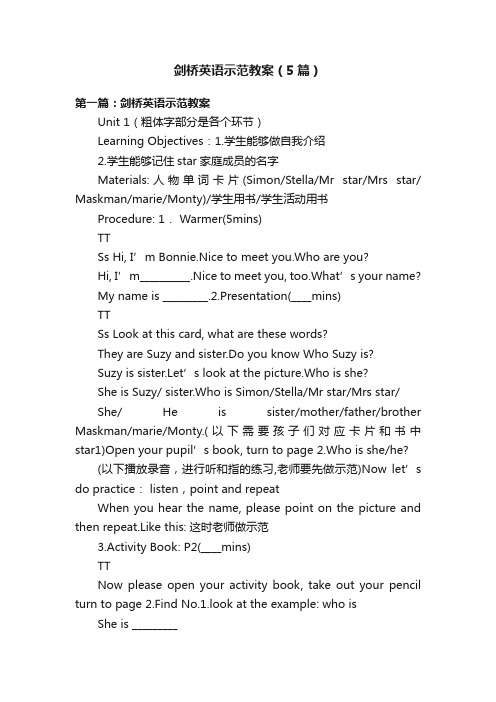
剑桥英语示范教案(5篇)第一篇:剑桥英语示范教案Unit 1(粗体字部分是各个环节)Learning Objectives:1.学生能够做自我介绍2.学生能够记住star家庭成员的名字Materials:人物单词卡片(Simon/Stella/Mr star/Mrs star/ Maskman/marie/Monty)/学生用书/学生活动用书Procedure: 1. Warmer(5mins)TTSs Hi, I’m Bonnie.Nice to meet you.Who are you?Hi, I’m__________.Nice to meet you, too.What’s your name?My name is _________.2.Presentation(____mins)TTSs Look at this card, what are these words?They are Suzy and sister.Do you know Who Suzy is?Suzy is sister.Let’s look at the picture.Who is she?She is Suzy/ sister.Who is Simon/Stella/Mr star/Mrs star/She/ He is sister/mother/father/brother Maskman/marie/Monty.(以下需要孩子们对应卡片和书中star1)Open your pupil’s book, turn to page 2.Who is she/he?(以下播放录音,进行听和指的练习,老师要先做示范)Now let’s do practice: listen,point and repeatWhen you hear the name, please point on the picture and then repeat.Like this: 这时老师做示范3.Activity Book: P2(____mins)TTNow please open your activity book, take out your pencil turn to page 2.Find No.1.look at the example: who is She is _________Mr star/ Mrs star``````Ssshe is Suzy,she? Now we should find the shadow of Suzy, and then draw a line to link them.When you finish, you should exchange your book with yourShe/he is _____ partner, and then check the work.(老师同样这时要做示范告诉孩子如何做)Did you see star 2? Let’s listen and circle the tick or cross,Look here, this is Marie, yes or no?So we use cross ╳to represent noThis is Simon, yes or no?So we use tick to represent yes√No we will listen to the video and then circle the tick and cross Are you ready? When you finished, please exchange your book, check your answer Who is she/he?No, This is Simon.yes!学生要大声说出答案And tell me the right answer.4.Games(______mins)TT It’s game ti me, everyone stand up, let’s stand in a circle.your name.I have a ball, I should say :I’m Bonnie and then I throw my ball to Lisa, I need ask lisa: what’s your name? Lisa hold the ball and answer my question, after that she needs to throw the ball to others.The person who holds the ball should tell us your name and say what’s your name?5.Ending(_____mins)TTLet’s review what we learned today, who is she/he?I’m Lisa, what’s SsShe /he is _______Please say good bye to Mr star```````good bye , Mr star 6.Homework 课后反思:今天上课的优点1.2.3.不足及提升方案:1.2.第二篇:剑桥英语剑桥少儿英语预备级上册unit1详细教案Unit1 Greetings一.课文地位:作为教材的第一课,对学生培养学习兴趣有很重要的作用。
【精编范文】剑桥英语教案-范文模板 (4页)

本文部分内容来自网络整理,本司不为其真实性负责,如有异议或侵权请及时联系,本司将立即删除!== 本文为word格式,下载后可方便编辑和修改! ==剑桥英语教案英语学习能力的提高一直是大家所烦恼的一个问题,只有不断练习才会有进步。
以下是小编整理的剑桥英语教材及教案,欢迎阅读。
剑桥英语教案11.教学目的和要求Teachingaimsanddemands:通过学习,使学生掌握几种打招呼的不同说法复习和学习一些外国小朋友的英文名掌握有关学习用品的英文名称和句子2.交际用语Expressionsincommunication:Hello,yourname,please?Thisismynewbook.Hi!I’mPat.HisnameisBill.Billismyfriend.Nicetomeetyou.Showmeyoupen.3.重点朗读词汇Keywordsandexpressions:apen,apencil,apencil-case,aruler,abook,abag,aneraser,my,you,his.男孩名字;Sam,Bill,Alex,Tom,Ben,Fan,Dan.女孩名字;Pat,Lucy,Ann,Sue,May,Jill,Lan,Kim剑桥英语教案21.教学目的和要求Teachingaimsanddemands:通过学习,要求学生首先学会有关动物词汇的发音,做到读音准确。
保证见图能说英文名称,见词能反应大概是什么意思。
学习和掌握字母e的读音。
能用句型进行简单的对话。
2.交际用语Expressionsincommunication:What’sthis,Mr.Li?It’sagoat.It’salongtail.Smile,please!Thisismycat,Iloveit.3.重点朗读词汇Keywordsandexpressions:ahorse,afish,aduck,aturtle,,acow,arabbit,acat,achicken,adog,asheep,af rog,agoat,剑桥英语教案31.教学目的和要求Teachingaimsanddemands:通过学习,初步掌握水果名称的读音。
《剑桥国际英语教程》教学标准剑一上

Unit1 Please call me Beth.Cycle1—Part1-5�主题:介绍自己和他人以及相互问候。
�主要语法:be 动词的用法和形容词性物主代词。
�功能项:(1)向初次见面的朋友介绍自己,例如:姓名,外貌特征,来自的国家(2)形容词性物主代词和名词性物主代词的区别使用�目标词汇:四会单词:听、说、写、用;三会单词:听、说、用;拓展单词:基本了解,难点提前预知。
�【part 5】目标语法:系动词be 用法。
例句分析:一.系动词 be 的用法例句1.I am a girl=I'm a girl2.You are a girl=You're a girl.3.He is a boy.=He's a boy.4.She is a girl.=She's a girl.5.It is a tree.=It's a tree.6.We are students.=We're students.7.They are students=They're students.练习题:1.I from China.2.He from America.3.My name Helen.二.形容词性物主代词例句1.Our teacher is coming.2.My mom is a teacher.3.Your mom is a doctor.练习题:1. sister is a student.2. name is Silva.3.Where is book? I can't find it.三.特殊疑问句例句1.What do you do?2.Where is ShanDong University?3.Which book is yours?练习题:1. is your home?2. is your name?3. pen is it?课堂流程各部分时间分配:(110 分钟课时量)本单元世界之窗(文化):Seoul:是大韩民国的首都,也是韩国最大的城市。
新版剑桥一级标准教案Unit One NEW

Ss:No.
T:You should do like this “Xu” ok? Now, this is Team 1, this is Team 2. Let’s have a match.
ⅢDifficult points:
语音难点:this, nice, I’m, name
理解难点:Your name, please?
态度难点:介于学与玩。既要能让学生感受到课堂游戏的快乐,同时还是要有学习知识的压力存在。
ⅣTeaching tools:
1.已有教具使用和目的:
磁带:复习巩固当堂所学知识,回归课本,老师再逐句教授。
新版剑桥一级Unit One标准教案
ⅠLesson Type:
New lesson
ⅡContents & Purposes:
1.Sentences:
新句学习内容及目标:
口语:掌握打招呼的几种用法。
1. Hello, your name, please?2. Hi! I’m Pat.3. Nice toseeyou.
Ss:YourΒιβλιοθήκη name, please?T:Then how to answer?(那么怎么回答呢?)用“I’m加上自己的名字”ok?
Ss:Ok.
T:1. Now I will teach you a very beautiful song, listen to me carefully! I’m, I’m, m~~~~/I’m, I’m, m~~~~/Name, name, m~~~~/ Name, name, m~~~~
剑桥大学英语入门教学教案

课时:2课时年级:初学者教学目标:1. 让学生掌握英语字母表的基本知识。
2. 培养学生基本的英语听说读写能力。
3. 激发学生对英语学习的兴趣。
教学内容:1. 英语字母表2. 基本发音规则3. 简单的日常用语教学过程:第一课时:一、导入新课1. 教师播放一段英文歌曲,激发学生的学习兴趣。
2. 学生分享自己对英语学习的看法和期望。
二、学习英语字母表1. 教师展示字母表,讲解每个字母的发音和书写方法。
2. 学生跟读,教师纠正发音。
3. 学生尝试书写字母,教师检查并指导。
三、基本发音规则1. 教师讲解基本发音规则,如元音、辅音、重音等。
2. 学生练习发音,教师点评并指导。
四、课堂练习1. 学生分组进行字母表接龙游戏,巩固字母知识。
2. 学生互相询问对方的名字和年龄,使用所学日常用语。
五、总结与反馈1. 教师总结本节课所学内容,强调重点。
2. 学生分享学习心得,教师点评并给予鼓励。
第二课时:一、复习导入1. 教师带领学生回顾上节课所学内容,检查学习效果。
2. 学生分享自己在英语学习过程中的收获。
二、学习日常用语1. 教师讲解简单的日常用语,如问候、介绍、道别等。
2. 学生跟读,教师纠正发音。
三、课堂练习1. 学生分组进行角色扮演,模拟日常生活场景,使用所学日常用语。
2. 教师巡视指导,纠正发音和语法错误。
四、课堂游戏1. 学生进行“我说你做”游戏,巩固所学日常用语。
2. 教师点评并给予鼓励。
五、总结与反馈1. 教师总结本节课所学内容,强调重点。
2. 学生分享学习心得,教师点评并给予鼓励。
教学评价:1. 学生对英语字母表、基本发音规则和日常用语的掌握程度。
2. 学生在课堂练习和游戏中的参与度和表现。
3. 学生对英语学习的兴趣和积极性。
教学反思:1. 教师根据学生的学习情况,调整教学内容和教学方法。
2. 注重培养学生的听说读写能力,提高学生的英语综合素质。
3. 激发学生的学习兴趣,营造良好的英语学习氛围。
剑桥英语教案设计模板
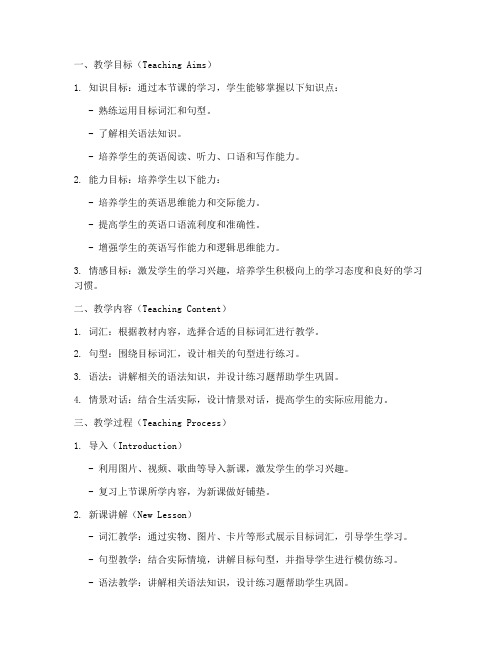
一、教学目标(Teaching Aims)1. 知识目标:通过本节课的学习,学生能够掌握以下知识点:- 熟练运用目标词汇和句型。
- 了解相关语法知识。
- 培养学生的英语阅读、听力、口语和写作能力。
2. 能力目标:培养学生以下能力:- 培养学生的英语思维能力和交际能力。
- 提高学生的英语口语流利度和准确性。
- 增强学生的英语写作能力和逻辑思维能力。
3. 情感目标:激发学生的学习兴趣,培养学生积极向上的学习态度和良好的学习习惯。
二、教学内容(Teaching Content)1. 词汇:根据教材内容,选择合适的目标词汇进行教学。
2. 句型:围绕目标词汇,设计相关的句型进行练习。
3. 语法:讲解相关的语法知识,并设计练习题帮助学生巩固。
4. 情景对话:结合生活实际,设计情景对话,提高学生的实际应用能力。
三、教学过程(Teaching Process)1. 导入(Introduction)- 利用图片、视频、歌曲等导入新课,激发学生的学习兴趣。
- 复习上节课所学内容,为新课做好铺垫。
2. 新课讲解(New Lesson)- 词汇教学:通过实物、图片、卡片等形式展示目标词汇,引导学生学习。
- 句型教学:结合实际情境,讲解目标句型,并指导学生进行模仿练习。
- 语法教学:讲解相关语法知识,设计练习题帮助学生巩固。
3. 情景对话(Scenario Dialogue)- 设计生活化的情景对话,让学生在真实语境中运用所学知识。
- 鼓励学生积极参与,培养他们的口语表达能力。
4. 练习巩固(Practice and Consolidation)- 设计听、说、读、写等多种形式的练习,帮助学生巩固所学知识。
- 针对学生的不同水平,进行分层教学,确保每个学生都能有所收获。
5. 总结(Summary)- 回顾本节课所学内容,强调重点和难点。
- 布置课后作业,巩固所学知识。
四、教学评价(Teaching Evaluation)1. 课堂表现:观察学生在课堂上的参与度、合作能力、口语表达能力等。
剑桥教师教案设计案例模板

一、教学目标1. 知识与技能目标:(1)学生能够听懂、会说、会读单词:father,mother,sister,brother,grandma,grandpa。
(2)学生能够运用所学单词和句型进行简单的对话交流。
2. 过程与方法目标:(1)通过图片、视频等多种形式,激发学生学习兴趣,提高学生的观察能力和思维能力。
(2)通过小组合作、角色扮演等活动,提高学生的口语表达能力和团队协作能力。
3. 情感态度与价值观目标:(1)让学生了解家庭成员的称呼,培养学生的家庭观念。
(2)通过学习,使学生学会关爱家人,珍惜亲情。
二、教学重点与难点1. 教学重点:(1)掌握家庭成员的称呼:father,mother,sister,brother,grandma,grandpa。
(2)学会运用句型:“My mother/father is...”进行介绍。
2. 教学难点:(1)正确发音家庭成员的称呼。
(2)灵活运用句型进行对话。
三、教学准备1. 教师:多媒体课件、图片、视频、单词卡片。
2. 学生:准备家庭成员的照片或相关资料。
四、教学过程(一)导入1. 教师播放一段家庭欢乐的短片,引导学生说出片中家庭成员的称呼。
2. 教师提问:“你们家里有哪些成员?”3. 学生回答,教师板书家庭成员的称呼:father,mother,sister,brother,grandma,grandpa。
(二)新授1. 教师展示单词卡片,带领学生认读家庭成员的称呼。
2. 学生跟读,教师纠正发音。
3. 教师播放相关视频,让学生观察并模仿家庭成员的称呼。
4. 教师提问:“你的妈妈叫什么名字?”5. 学生回答,教师板书句型:“My mother is...”6. 教师展示家庭成员的照片,让学生用所学句型进行介绍。
(三)巩固练习1. 小组活动:每组学生抽取一张家庭成员的照片,用所学句型进行介绍。
2. 角色扮演:教师和学生分组,分别扮演家庭成员,进行对话交流。
剑桥英语教案
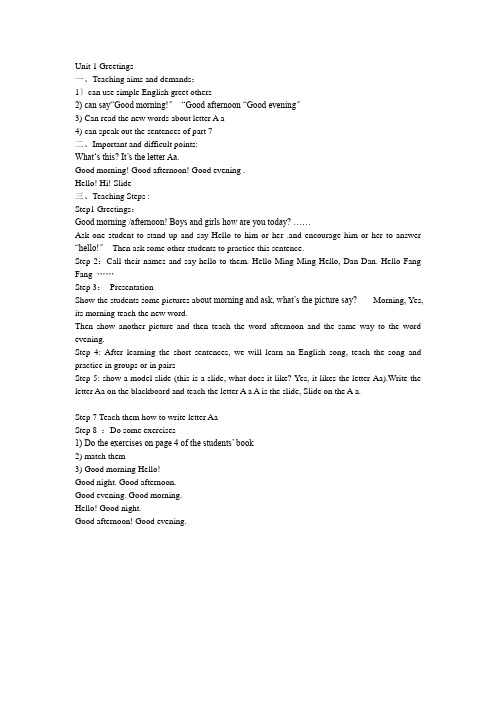
Unit 1 Greetings一、Teaching aims and demands:1〕can use simple English greet others2) can say“Good morning!〞“Good afternoon “Good evening〞3) Can read the new words about letter A a4) can speak out the sentences of part 7二、Important and difficult points:What‘s this? It’s the letter Aa.Good morning! Good afternoon! Good evening .Hello! Hi! Slide三、Teaching Steps :Step1 Greetings:Good morning /afternoon! Boys and girls how are you today? ……Ask one student to stand up and say Hello to him or her .and encourage him or her to answer “hello!〞Then ask some other students to practice this sentence.Step 2:Call their names and say hello to them. Hello Ming Ming Hello, Dan Dan. Hello Fang Fang ……Step 3:PresentationShow the students some pictures ab out morning and ask, what’s the picture say? ---- Morning, Yes, its morning teach the new word.Then show another picture and then teach the word afternoon and the same way to the word evening.Step 4: After learning the short sentences, we will learn an English song, teach the song and practice in groups or in pairsStep 5: show a model slide (this is a slide, what does it like? Yes, it likes the letter Aa).Write the letter Aa on the blackboard and teach the letter A a A is the slide, Slide on the A a.Step 7 Teach them how to write letter AaStep 8 :Do some exercises1) Do the exercises on page 4 of the students’ book2) match them3) Good morning Hello!Good night. Good afternoon.Good evening. Good morning.Hello! Good night.Good afternoon! Good evening.。
- 1、下载文档前请自行甄别文档内容的完整性,平台不提供额外的编辑、内容补充、找答案等附加服务。
- 2、"仅部分预览"的文档,不可在线预览部分如存在完整性等问题,可反馈申请退款(可完整预览的文档不适用该条件!)。
- 3、如文档侵犯您的权益,请联系客服反馈,我们会尽快为您处理(人工客服工作时间:9:00-18:30)。
剑桥标准英语教程-教案Unit 3 HealthTeaching objectivesIn this unit, Ss learn how to …◆use the simple present and present continuous.◆use if and when in statements and questions.◆talk about health, remedies, sleep habits, and stress.◆encourage people to talk by making comments and askingfollow-up questions.◆use expressions like Wow! and Y ou’re kidding! to show surprise. Main Points of TeachingEnable Ss to talk about health, remedies, sleep habits, and stress. Difficult Points of TeachingEnable Ss to use the simple present and present continuous. Teaching Periods6 teaching hoursTeaching proceduresUnit opening pageIntroduce the theme of the unit This unit is about health. What are some things you can do to stay healthy? Write all the responses on the board.In Unit 3, you learn how to…⏹Unit aims Read the unit aims aloud. Tell Ss to listen and readalong.Before you begin…⏹Introduce the health tips Tell Ss to cover the words below thepictures and look at the pictures. Say, “These four pictures show things people can do to stay healthy. Work with a partner and write a short sentence about the health tip in each picture.”⏹Ask several pairs to share their tips with the class. Write theirsentences on the board.⏹Read the sentences below the pictures aloud. Ss listen and repeat.Help with new vocabulary as needed. Ss practice reading the sentences.⏹Ask the class, “Which of the things in the pictures do u do to stayhealthy?” Have several Ss answer. Ask, “What else can u do? Use ideas from the board, or think of more things to do.”⏹Ss ask and answer in pairs. Then ask several Ss to report theiranswers to the class.Lesson A Healthy living1 Getting started⏹Ste the scene Read the lesson title aloud. Ask, “What are somethings u do to stay healthy?” Ask a few Ss to answer. Ask, “Who is doing sth special, or different, to stay or get healthy right now?”Ask a few Ss to answer.A⏹Preview the task Read the instructions aloud.⏹Play the recording First, Ss read along. Then Ss listen withoutlooking at books and write their answers.⏹Have Ss compare their answers in pairs. Check answers with theclass.B⏹Preview the task Say, “Read the interviews again. Look for timewords and expressions. Write these column headings on the board: Routines (All the time) and Temporary Events (Now). Ask a few Ss to call out the time expressions for the first headings, and write them on the board. Ask, “What verb tense do u see in the sentences with these time expressions?”⏹Ask a few Ss to call out the time expressions for the secondheading, and write them on the board. Ask, “What verb tense do u see in the sentences with these time expressions?”⏹Read the instructions aloud.⏹Do the task.⏹Have Ss compare their answers in pairs. Check answers withclass.2 Grammar⏹Present the grammar chart⏹Understand the grammar Say, “The grammar chart compares thesimple the simple present and the present continuous.”Explainthat the simple present is used to talk about regular or repeated events or routines and situations are true all the time. And the present continuous is used for activities and events that are temporary, or going on around now. It is also used for activities that are going on at the time of speaking.⏹Present In Conversation Read the information aloud. Have Ssmake a sentence in the simple present for each of the verbs presented.A⏹Preview the task Have Ss look at the picture. Ask, “What is shedoing?” Ask, “What is on the table?” (an aromatherapy burner) Read the instructions and the example aloud. Ask, “Why is the simple present the correct tense?”(It’s asking how u cope with stress in general or all the time.)⏹Do the task2 Listening and speakingA⏹Preview the task Say, “Y ou will hear four people talking abouttheir unhealthy habits. Read the incomplete statements and guess what each person says. Write your guesses.”⏹When Ss finish, ask a few Ss to call out their guesses for eachstatement. Say, “Now listen and write what they actually say.”⏹Play the recording Ss listen and write the missing words. Checkanswers with the class.Lesson B Aches and pains1 Building vocabulary⏹Ste the scene Hold your head as if it hurts. Say, “I have aheadache.” Write a headache on the board. Hold your stomach as if it hurts. Say, “I have a stomachache.”Write it on the board.Ask, “What other health problems do u know the words for in English?” Write Ss’ responses on the board.A⏹Preview the task Read the instructions aloud. Have SS look at thepictures.⏹Play the recording Ss listen and repeat.⏹Ask, “Do u have any of these problems right now? If yes, raiseyour hand.” Ask any Ss who raise their hands, “Which problemdo u have?”B⏹Preview the task Ask Ss to look at the chart. Read the instructionsaloud. Tell Ss to use ideas from the lists on the board or their own ideas.⏹Do the task2 Speaking naturallyA⏹Preview the task Have Ss look at the conversation. Say, “Whenpeople are speaking, they put stress on the words that are important in the sentence. An important word can be, for example, the answer to a question.”Say, “Stress is also used to contrast, or correct, information. For example, imagine I call u by the wrong name. When u correct me, u say your name clearly anda little more loudly.”⏹Read the instructions aloud.⏹Play the recording Ss listen and repeat.B⏹Preview the task Tell pairs to practice the conversation in Part A,taking turns playing each role. Read the instructions aloud.⏹Do the task3 Building language⏹Set the scene Write on the board: remedy. Explain, “A remedy isused to fix a problem. For example, one remedy for a headache is to take an aspirin. Imagine you have a cold. What remedy do u use?” Write Ss’ responses on the board.A⏹Preview the task Look at the picture. Say, “Sonia and Mark aretalking on the phone. Where’s Mark?” (at home) “What’s wrong with her?”(He’s sick.) “What do u think Sonia and Mark are talking about?” (a remedy)⏹Books closed. Say, “What does Sonia want to make for Mark?Listen and write the answer.”⏹Play the recording For the first time, Ss listen and write theanswer without looking at books; for the second time, Ss listen, read along, and review their answer. Then check the answer with the class⏹Practice the conversation in pairs.B⏹Preview the task Tell Ss to find if and when in the conversationand circle them. Ask, “What tense are the two verbs in each sentence?”⏹Do the task4 Grammar⏹Present the grammar chart⏹Understand the grammar Say, “When and if have very similarmeanings. You can use when to talk about a situation that is usual for u, and u can use if to talk about a situation that is not so usual.But both are possible in the sentences in the chart.”A⏹Preview the task Read the instructions and the phrases from No.1 aloud. Read the example conversation. Remind Ss that they canput the part with when at the start of the sentence or after the other part. Have Ss complete the task.⏹Have Ss check answers in pairs. Then check answers with theclass.B⏹Preview and do the task.Lesson C How come you’re tired?1 Conversation strategy⏹Set the scene Read the title of the lesson aloud. Ask, “What doeshow come mean?” (why) Say, “Think about the title. Try to guess some of the words that are in the conversation in this lesson.” As Ss call out their guesses, write them on the board.A⏹Preview the task Tell Ss to look at A’s statement. Read it aloud.Say, “Read B’s responses. Which are the best to keep the conversation going? Check the boxes.”Have Ss compare their answers in pairs. Check answers with the class.⏹Books closed. Read the instructions aloud.⏹Play the recording Books open. Ss listen and read along.⏹Play the recording again Ask, “Why is Adam tired?” Ss listen andwrite the answer.⏹Play the recording again Ss listen, read along, and review theiranswers. Check answers with the class.⏹Ask Ss to read the conversation again and circle any words thatthey guessed would be in the conversation. As Ss call them out, circle them on the board.⏹Practice Have Ss practice the conversation in pairs.B⏹Preview the task Have Ss read the sentences and replies.⏹Do the taskC⏹Preview and do the task Read the instructions aloud. To modelthe task, have two Ss read the example conversation. Have pairs use the sentences in Part B for ideas and give their own answers.Remind Ss to say more than just yes or no.2 Strategy plus⏹Find examples Say, “Look at the conversation on p.26 again. Findthe expressions that Yuki uses to show surprise.⏹Present Strategy plus Read the information and the examplesaloud. Ask, “Why does Yuki say ‘Y ou’re kidding!’”⏹Present In Conversation Books closed. Write on the board: Oh,Wow, Really, and Gosh. Say, “Two of these are in the top 50 words, and two are in the top 500 words. Which two are in the top 50?Which two are in the top 500? Write your guesses.” Books open.Ask a S to read the information. Have Ss raise their hands if they guessed correctly.A⏹Preview the task Have Ss read the conversations. Say, “Now listenand write the expressions you hear.”⏹Play the recording Ss listen and read along. Listen again andwrite the expressions.⏹Check answers with the class.⏹Have Ss practice the conversation in pairs.B⏹Preview the task.⏹Play the recording Ss listen, then write the expression. Ss listenagain. Then check answers with the class.3 Talk about it⏹Preview the task Read the instructions aloud. Ask Ss to read thediscussion questions. Make sure that Ss understand the meaning of each question.⏹Do the task Have Ss discuss the questions in groups. Say, “Whenu find sth u have in common, make notes.”Lesson D Ways to relax1 Reading⏹Set the scene Read the title of the lesson aloud. Ask, “How do urelax? What do u do?” Get ideas from Ss.APrereading⏹Preview the task Write the word stressed on the board. Ask,“What does stressed mean?” Get ideas from Ss.⏹Do the taskBDuring reading⏹Preview the reading Have Ss look at the reading. Say, “This is aleaflet. A leaflet is usually one piece of paper with helpful information.”⏹Read the instructions aloud. Tell Ss to circle two new orinteresting things they learn as they read.⏹Do the reading Have Ss rend the leaflet and circle theinformation.⏹When Ss finish, call on a few Ss to tell the class the informationthey circled.⏹Do the reading again Have Ss read the leaflet again and underlineany new vocabulary. Help with new vocabulary as needed.CPostreading⏹Preview the task⏹Do the task Have Ss answer the questions and then compare theiranswers pairs. Check answers with the class.2 Listening⏹Set the scene Tell Ss to look at the pictures. Ask, “Where are thepeople? What are they doing?” Get ideas from Ss.A⏹Preview and do the task Read the instructions aloud. Have Sswork in pairs and discuss the questions⏹Call on several Ss to tell the class what they do to relax.B⏹Preview the task Read the instructions aloud.⏹Play the recording Play the first conversation. Ask, “Whichpicture does this conversation go with?” Then ask, “What words in the conversation help u choose this picture?”⏹Play the remaining conversations, and have Ss write theiranswers. Check answers with the class.C⏹Preview the task Read the instructions aloud.⏹Play the recording Play the first conversation, and then pause therecording. Ask, “What else does she do to relax?”Ss write the answer under the picture they labeled 1.⏹Play the remaining conversations. Ss listen and write theactivities.⏹Play the recording again Ss listen and review their answers.Check answers with the class.3 WritingA⏹Preview the task Ask some general questions about commonhealth problems.⏹Read the instructions aloud. Call on four Ss to each read anexample.⏹Do the task Have Ss write a common health problem on a piece ofpaper.B⏹Preview the task Read the instructions aloud. Call on different Ssto each read the example problem and the replies.⏹Present the Help note⏹Ask Ss to read some of the problems they wrote in Part A. Givesuggestions using sentences with if when clauses.⏹Do the task Have Ss pass their papers around their group, andwrite a reply to each person.。
